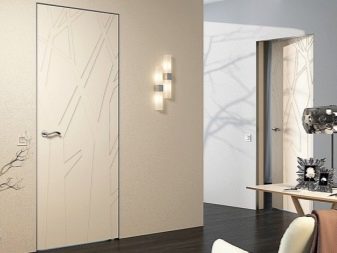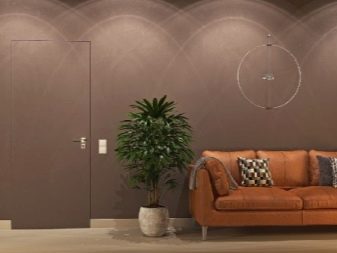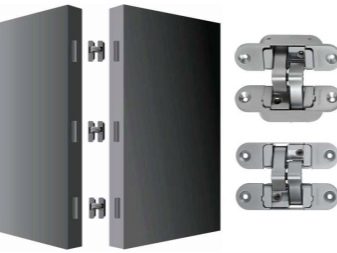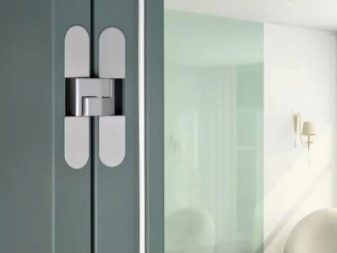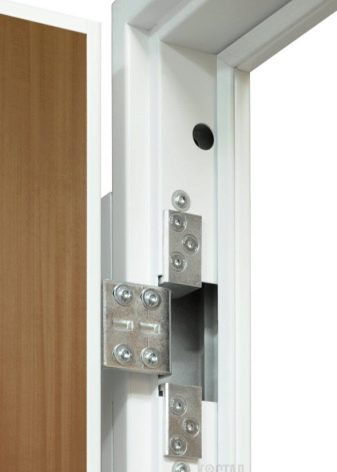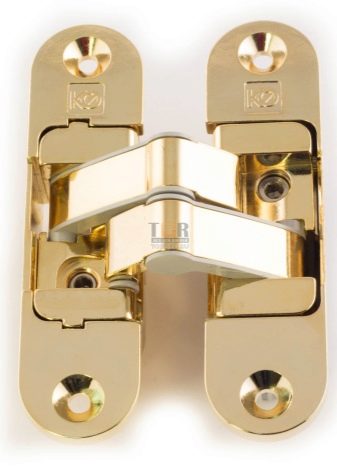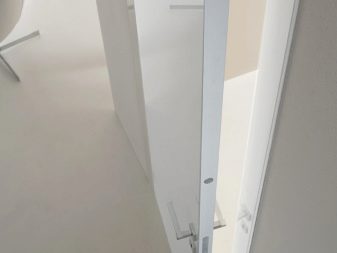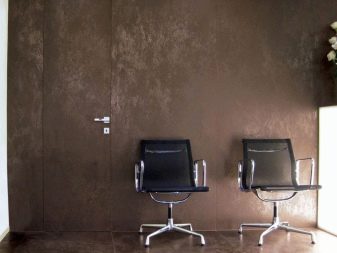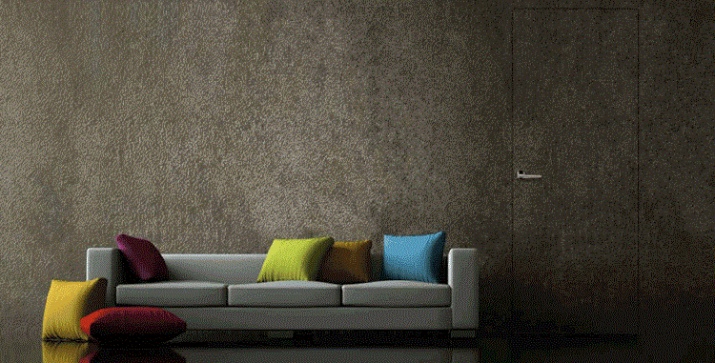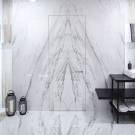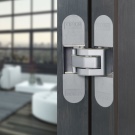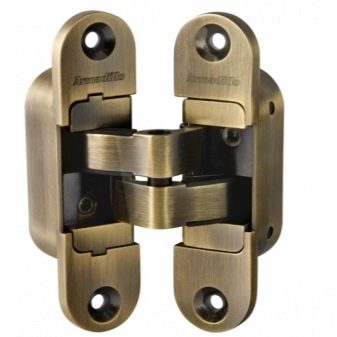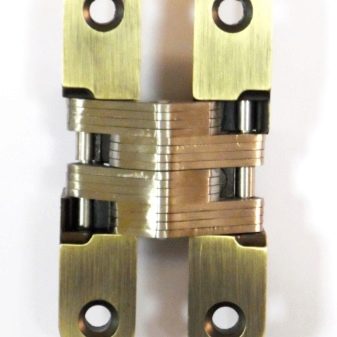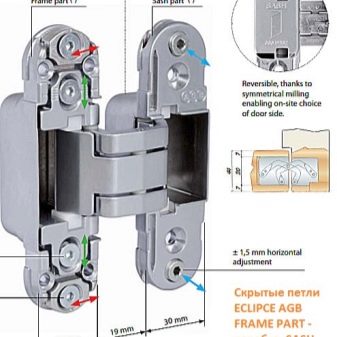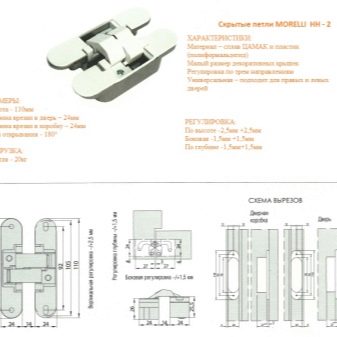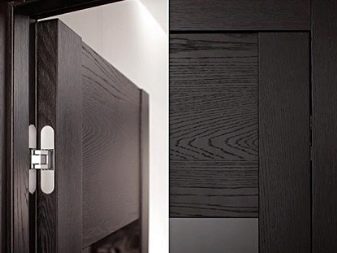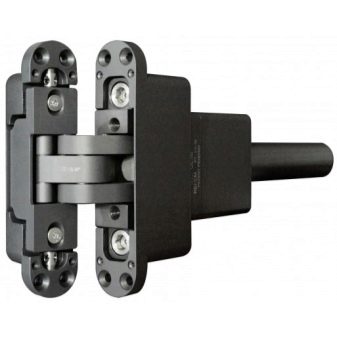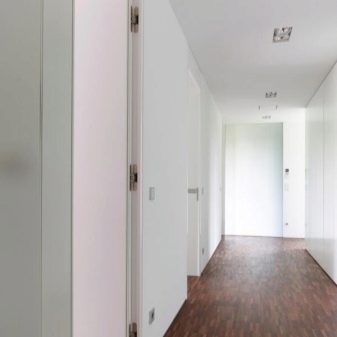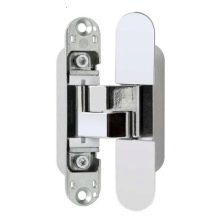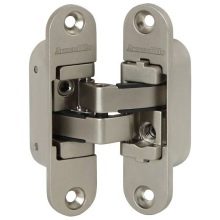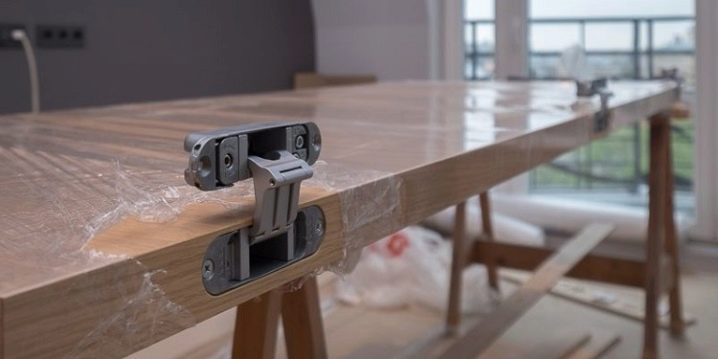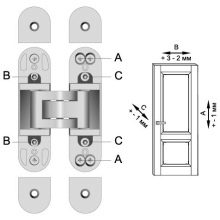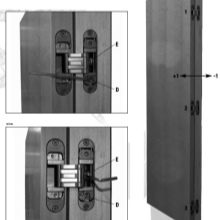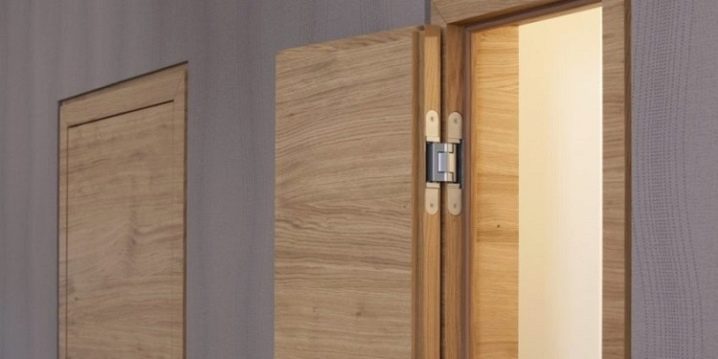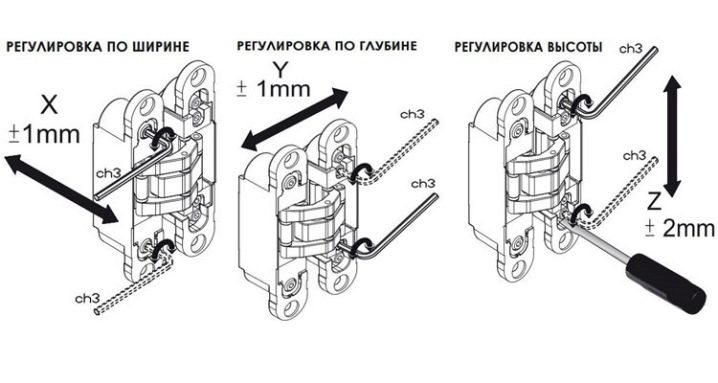Hidden hinges for doors: features of choice and installation
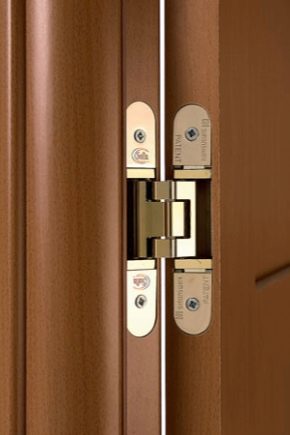
Hidden door hinges are an important element of the door hardware and are widely used when installing entrance and interior systems. Appearing in a mass sale about 25 years ago, the product immediately attracted the attention of consumers and quickly gained popularity.
Special features
Hidden hinges are a structure consisting of a metal body, a secret hinge inside this body, a lever and an anti-friction bushing, designed for better sliding. The lever, in turn, consists of 2 parts interconnected by means of a movable axis made of steel and providing the connection between the hinges and the web. There are three types of hidden loops: left-handed, right-handed and universal.
And if the latter are able to function, being installed on either side of the canvas, then the first two types have a narrow specialization and can only be installed on a certain side. Internal loops provide the mobility of the web by 180 degrees and are capable of withstanding up to 200,000 opening-closing cycles. In addition, the devices provide an easy and silent course of the door leaf, do not allow spontaneous separation of the door from the box and have the ability to fix it in the extreme positions.
The material for the manufacture of hidden door canopies is an alloy called Tsak, which includes aluminum, magnesium, copper and zinc. Tsamak is absolutely safe for the health of others and is highly durable and wear resistant. The alloy is well cast at sufficiently low melting points and is distinguished by a smooth surface and uniform structure.
Finished products are coated with chrome, brass or remain dull. This allows you to produce models in a wide range of design and color, which greatly facilitates the choice when buying them.
Hinges for heavy metal doors are made from high-alloy steel. The metal has much greater strength in comparison with the alloy and is able to withstand serious weight loads. In addition, steel hinges are not susceptible to corrosion and are highly resistant to extreme temperatures. This allows you to install internal loops on garages, warehouses and entrance groups of private and multi-family houses.
Hidden hinges are an indispensable type of door hardware when installing doors with overlap (with a quarter). The peculiarity of such systems consists in the method of door curtain to the door frame, which can be made in the form of a quarter on the canvas and a response quarter on the box, or a quarter, made only on the canvas and forming a vestibule with an overlap at closing. The design features of the door unit do not involve the use of classic hinges and are designed only for the installation of internal fittings.
Advantages and disadvantages
High consumer demand and The growing popularity of hidden hinges are due to a number of undeniable advantages of these accessories.
- Doors equipped with hidden hinges are characterized by high burglary resistance and significantly reduce the likelihood of illegal entry into the room. Hidden models are completely hidden in the door leaf, so it is almost impossible to cut or cut them.
- A large variety of models of different capacities and sizes allow you to choose a product for both a wardrobe closet and a powerful armored door.
- Due to the large opening angle, the canvas can swing open to the adjacent wall, which is quite convenient when moving large items through the door.
- The installation technology of hidden models assumes that they are completely buried in the box and door leaf. This allows the loops to withstand very serious mechanical loads and gives the structure sufficient rigidity.
- Aesthetic component. Internal hinges do not clutter the door leaf and can be installed on any type of door structures, including systems with an “invisible box” and secret doors in an office or apartment.
- The high reliability of the internal loops allows them to withstand a much greater load than traditional canopies can withstand.For example, models for interior doors can easily withstand weight up to 50 kg, while their counterparts are designed only for 30 kg. The same situation is with products for metal canvases: especially durable models can withstand up to 300 kg of weight, which also exceeds the endurance of conventional loops by more than 90 kg.
- The ability to adjust in three planes makes hidden hinges indispensable elements of door hardware when installed in new buildings. Often, a few years after construction, new houses begin to shrink, which inevitably leads to a distortion of the door frames and poor closing of the doors.
- The versatility of many models is due to the possibility of their installation both on wood, and on plastic and metal cloths.
The disadvantages include the rather high cost of many products. For example, a fairly common model for interior doors Armadillo 3D-ACH-40, regulated in three planes (in depth, height and width) and related to the average price category, costs 1890 rubles. Hinges for metal doors are much more expensive. So, the Italian model SPEV250 will cost two and a half thousand rubles.There are, of course, options for 600 and even for 300 rubles, but these are likely to be low-quality products that are not able to be regulated and can quickly fail. In addition, some sheds have a non-separable structure, which, if necessary, removes the hinges if necessary to remove the doors.
Also, the disadvantages include quite large sizes of hidden models.that is not always convenient when installing. First of all, this concerns products for interior canvases, during installation of which it is often found that there is simply no place for the location of such loops. This is especially true for door frames in which the wall thickness is so minimal that the depth to install a carport may not be enough.
Some nuances of installation are also attributed to the disadvantages of hidden loops. There is a need to form niches in the door leaf and box, which, with the slightest inaccuracy, can lead to damage to the decorative surface and the loss of the attractiveness of the door.
Species
The classification of hidden door hinges occurs on a number of grounds.
- Adjustment. According to this criterion, the models are divided into adjustable and unregulated.The first are the most versatile and allow you to change the position of the door leaf, without removing it from the hinges. Adjustment is usually carried out in three planes, so you can not only raise or lower the door, but also adjust the density of its fit to the door frame. Such models are somewhat more expensive than unregulated products, but the difference in price is fully justified by the ease of use. Unregulated loops it is reasonable to install on a stable, not prone to deformation of the system. For example, in a metal garage or wardrobe installation of such products would be quite appropriate.
- Power. On this basis, models are divided into products for interior doors and canopies for heavy steel canvases. The former are able to withstand up to 60 kg, while the latter can easily cope with a weight of 300 and even 350 kg. Often an important condition for the operation of canopies on massive canvases is the need to use three or more copies at once, which allows for a more even distribution of the load on the loops and significantly increases their service life.
- Functionality. According to this feature, simple products and models with closers are distinguished. The latter appeared on the market of door hardware relatively recently and immediately attracted the attention of consumers. The engineers managed to connect a loop and a door closer in one device, due to which the need to install two mechanisms on one door at once was no longer necessary. Externally, the advanced models are not much different from the traditional ones, however, they have in their design a spring-damping mechanism, which, when opened, stretches the door and then slowly returns to its original position.
The sash also slowly begins to close until it reaches the door frame. The smoothness of the stroke of the canvas due to the presence of an oil shock absorber. The oil moves along the valve system along the cylinder with the spring, thus creating the desired resistance and not allowing the spring to compress quickly.
Models with a closer are designed for installation on wooden, aluminum and plastic doors, the weight of which does not exceed 90 kg. So, on a canvas weighing up to 50 kg it will be enough to install two loops, while on products weighing up to 90 kg it is recommended to install three loops.
How to choose?
When choosing hidden loops should pay attention to a number of nuances.So, it is better to purchase products from trusted manufacturers who produce high quality products and have a good reputation. The most famous and reliable manufacturers of sheds are Italian AGB, Armadillo and Krona Koblenz. These companies have long specialized in the production of door fittings and produce high-quality and time-tested models.
In addition to the brand, you need to focus on the technical components of the products. It is necessary to determine the location of the door and in accordance with this, select the model of the right or left execution. If the future arrangement of the furniture is not yet known for certain, or the side of opening the door has not yet been selected, then it is better to purchase universal models that can be operated on both sides.
The choice of frame size is also important. Thus, for a door weighing 15–25 kg, two short canopies of 6–7 cm long will suffice, while for doors weighing 40 kg, ten centimeter hinges will be needed. The number of canopies also depends entirely on the weight and dimensions of the door structure and amounts to 2 pieces for light and three for more for heavy canvases.
Installation
Installation of hidden canopies is not particularly difficult and can be done by hand. All work consists of several successive stages, the first of which is the formation of a niche in the canvas. To perform carpentry work, you need to stock up on a good tool, for example, a hand mill. The use of chisels can lead to inadvertent damage to the wooden coating, after which it will no longer be possible to restore the original look of the door.
Manual cutter should be equipped with a removable bed, which is attached to the door leaf or box. Included with the bed are usually several special templates, without which it will be impossible to form a neat niche. With the first template, a place is cut for the outer part of the loop, and with the second, a recess for the deep inside part of the canopy.
However, the bed and templates are not cheap, so for a one-time use to purchase such a tool does not make sense. In this case, you can use self-made templates, according to which, provided they are properly manufactured, you can form depressions no worse than the factory ones.For their manufacture, you can use a piece of strong plywood or a couple of plates.
It sometimes happens that when forming the bottom in-depth niche, the cutter sizes may not be enough. In this case, you should take a drill, put down a drill bit on it and make a few blind holes around the inner template. Then gently, using a knife and a hammer, you need to tap the extra wood and clean the edges of the niche. This is followed by a very crucial step in transferring the markings to the door frame strip. To do this, press the reciprocal bar against the door and draw risks in the right places. Then, using the same technology as described above, you need to form a niche in the door frame.
The next step will be the drilling of narrow holes under the screws for fixing the canopy. Screwing them without prior drilling is not recommended: if misused using a screwdriver, the hardware can go to the side and break the geometry of the loop. The final stage will be screwing the canopy and installing a decorative trim covering the regulating mechanism.
Adjustment
Adjustable canopies are reinforced and lightweight.Vertical adjustment of the latter is performed using a thin hex key. Screw for adjustment in such models is usually located in the upper part at the junction of the holders. The maximum value of the adjustment stroke is 1.5 mm. Horizontal adjustment is also made using a hexagon, and the adjustment screw is located in that part of the canopy, which is embedded in the canvas. The maximum working stroke of the mechanism is 1 mm. The adjustment of the clamping of the blade to the door frame is carried out with the help of an eccentric and is also performed with a hex key. The eccentric is located in that part of the canopy, which is installed in the box. The maximum stroke is also 1 mm.
Reinforced loops are regulated somewhat differently. Vertical adjustment is carried out by means of six screws and carried out by means of a six-sided key. The screws are located on the overhanged part of the box. Horizontal adjustment is also made with a hexagon using two screws located in the door. The clamp is adjusted by two screws that are in the box.
In this way,hidden hinges for door designs are practical and convenient to use by the invention. They are easy to install, completely invisible on the door leaf and can last for a very long time. In addition, the installation of hidden shelters significantly increases the inviolability of the home, which ensures maximum safety for residents.
In the next video you will find a tie-in of hidden loops.

